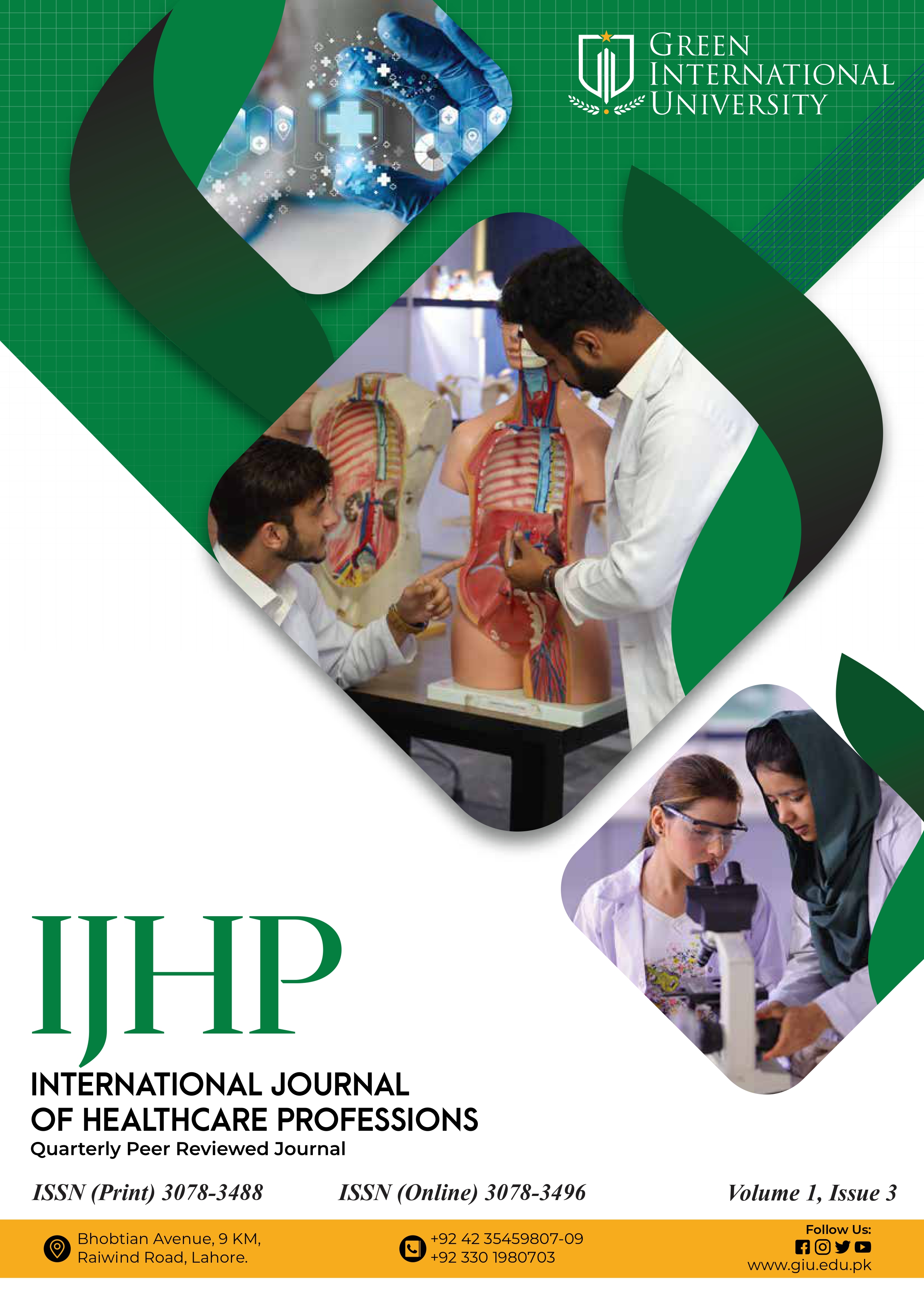Correlation of antimicrobial consumption and resistance among covid patients admitted to ICUin Lahore, Pakistan
DOI:
https://doi.org/10.71395/ijhp.1.3.2024.43-47Abstract
Background and Objectives: Antimicrobial resistance is a global problem and the leading cause of death and morbidity among patients admitted to medical intensive care units. In addition to correlating antibiotic consumption and antibiotic resistance with ICU demographic data, the study aims to ascertain whether clinical indications result in the recommendation of particular antibacterials for different patients admitted to the critical care unit. Another
objective of the study is to determine whether the use of antibiotics and microbial infections is associated with the recovery or death of the patient who was brought to the medical critical care unit.
METHODOLOGY: The study was conducted in a tertiary care hospital in Lahore. The study subjects were 100 people who were admitted in ICU. All the samples were collected after the permission of the hospital administration and consent from the patients were also taken before taking the samples. According to clinical doubt, lab samples were collected and tested for responsible organism and for their antibacterial susceptibility.
RESULTS: E. coli (32%) and Klebsiella pneumoniae (17%) were the most prevalent pathogens. The most resistant strains of Klebsiella pneumoniae were to amoxycillin (12.0%) and ampicillin (13.3%). Most E. coli was resistant to both ciprofloxacin (16.8%) and ampicillin (19.8%). The most frequent diagnoses were CKD and UTI (21.4%),
with E. coli accounting for 50% of these cases. In the intensive care unit, about 17 different kinds of antibiotics were utilized. Of all the antibiotics, quinolones, carbapenem, aminoglycosides, and fluoroquinolones were the most used. Liver failure and brain injuries result in the least amount of healing, whereas pyelonephritis causes the most.
CONCLUSION: Present study provided a useful data on clinical implication of antibiotic use in ICU patients especially with comorbidities. These data indicated that critical care patients in ICUs are disproportionately vulnerable to antimicrobial resistance, according to the data.
References
Ventola CL. The antibiotic resistance crisis: part 2: management strategies and new agents. Pharmacy and Therapeutics. 2015;40(5):344-346.
Pickens CI, Wunderink RG. Principles and practice of antibiotic stewardship in the ICU. Chest. 2019;156(1):163-71.
Laxminarayan R, Duse A, Wattal C, Zaidi AK, Wertheim HF, Sumpradit N, et al. Antibiotic resistance—the need for global solutions. The Lancet infectious diseases. 2013;13(12):1057-98.
Smith R, Coast J. The true cost of antimicrobial resistance. Bmj. 2013;346.
Dyar OJ, Castro-Sánchez E, Holmes AH. What makes people talk about antibiotics on social media? A retrospective analysis of Twitter use. Journal of Antimicrobial Chemotherapy. 2014;69(9):2568-72.
Lockhart SR, Abramson MA, Beekmann SE, Gallagher G, Riedel S, Diekema DJ, et al. Antimicrobial resistance among Gram-negative bacilli
causing infections in intensive care unit patients in the United States between 1993 and 2004. Journal of clinical microbiology. 2007;45(10):3352-9.
Remick DG. Pathophysiology of sepsis. The American journal of pathology. 2007;170(5):1435-44.
Vincent J-L, Rello J, Marshall J, Silva E, Anzueto A, Martin CD, et al. International study of the prevalence and outcomes of infection in intensive care units. Jama. 2009;302(21):2323-9.
Munoz-Price LS, Weinstein RA. Acinetobacter infection. New England Journal of Medicine. 2008;358(12):1271-81.
Bataineh HA, Alrashed KM. Resistant gram-negative bacilli and antibiotic consumption in Zarqa, Jordan. Pak J Med Sci. 2007;23(1):59-63.
Sánchez-Romero MI, Moya JMG-L, López JJG, Mira NO. Collection, transport and general processing of clinical specimens in Microbiology
laboratory. Enfermedades infecciosas y microbiologia clinica (English ed). 2019;37(2):127-34.
Tripathi N, Sapra A. Gram staining. 2020. Mohamad NA, Jusoh NA, Htike ZZ, Win SL. Bacteria identification from microscopic morphology:
a survey. International Journal on Soft Computing, Artificial Intelligence and Applications (IJSCAI). 2014;3(1):2319-1015.
Awong‐Taylor J, Craven K, Griffiths L, Bass C, Muscarella M. Comparison of biochemical and molecular methods for the identification of bacterial isolates associated with failed loggerhead sea turtle
eggs. Journal of applied microbiology. 2008;104(5):1244-51.
Hudzicki J. Kirby-Bauer disk diffusion susceptibility test protocol. American society for microbiology. 2009;15(1):1-23.
Tuem KB, Desta R, Bitew H, Ibrahim S, Hishe HZ. Antimicrobial resistance patterns of uropathogens isolated between 2012 and 2017 froma tertiary hospital in Northern Ethiopia. Journal of global antimicrobial resistance. 2019;18:109-14.
Mehta T, Chauhan B, Rathod S, Pethani J, Shah PD. Bacterilogical profile and drug resistance pattern of isolates of the patients admitted in medical intensive care unit of a tertiary care hospital in Ahmedabad.
Med Sci. 2015;4:222-5.
Sanjana R, Shah R, Chaudhary N, Singh Y. Prevalence and antimicrobial susceptibility pattern of methicillin-resistant Staphylococcus aureus (MRSA) in CMS-teaching hospital: a preliminary report. Journal of College of Medical Sciences-Nepal. 2010;6(1):1-6.
Alemu A, Moges F, Shiferaw Y, Tafess K, Kassu A, Anagaw B, et al. Bacterial profile and drug susceptibility pattern of urinary tract infection in pregnant women at University of Gondar Teaching Hospital,
Northwest Ethiopia. BMC research notes. 2012;5:1-7.
Barai L, Fatema K, Haq JA, Faruq MO, Ahsan AA, Morshed MAHG, et al. Bacterial profile and their antimicrobial resistance pattern in an intensive care unit of a tertiary care hospital of Dhaka. Ibrahim Medical College Journal. 2010;4(2):66-9.
Downloads
Published
Issue
Section
License
Copyright (c) 2025 International Journal of Healthcare Professions

This work is licensed under a Creative Commons Attribution 4.0 International License.
This is an open-access journal and all the published articles / items are distributed under the terms of the Creative Commons Attribution License, which permits unrestricted use, distribution, and reproduction in any medium, provided the original author and source are credited. For comments ijhp@giu.edu.pk






